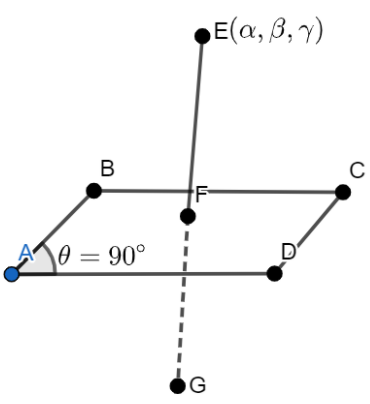
Reflection of the point $\left( \alpha ,\beta ,\gamma \right)$ in the XY plane is:
a). $\left( -\alpha ,\beta ,\gamma \right)$
b). $\left( \alpha ,\beta ,0 \right)$
c). $\left( 0,0,\gamma \right)$
d). $\left( \alpha ,\beta ,-\gamma \right)$
Answer
562.8k+ views
Hint: We will use the concept of 3-D geometry to find the reflection of point $\left( \alpha ,\beta ,\gamma \right)$in the XY plane. We will use the concept that when we take the reflection of any point in the XY plane then the x and y coordinate of the point remains the same and z-coordinate changes only in sign but magnitude remains the same.
Complete step-by-step solution:
From the question we can see that $\left( \alpha ,\beta ,\gamma \right)$ is a point which lies in the 3-D plane. Since, we have to find the reflection of point $\left( \alpha ,\beta ,\gamma \right)$in the XY plane.
Let us assume that ADCB is an XY plane and point E $\left( \alpha,\beta,\gamma \right)$ be the point that lies above the plane XY.

Let us say that AD is the x-axis and AB is the y-axis and AD is perpendicular to AB.
So, the distance of point E from the x-axis is $\alpha $, and the distance of point E from the y-axis is $\beta $ and that from the z-axis is $\gamma $.
Now, when we take the reflection of point E in the XY plane ADCB then we will get point G.
So, we can say that we have to move the same distance $\alpha $ on the x-axis(i.e. on line AD) and on the y-axis, we will also move the same $\beta $ distance but since G is opposite to E so we have to move in an opposite direction on the z-axis to reach point G but its magnitude is same as that of $\gamma $.
So, we can say that the point G is $\left( \alpha ,\beta ,-\gamma \right)$.
Hence, option(d) is the correct answer.
Note: Students are required to note that when we take the reflection of any point about XY then only the sign of z-coordinate changes and the rest of the coordinates remains the same. Similarly, when we take a reflection of point about YZ axis then the sign of only x-coordinate changes and the rest of things remains the same. Similarly, when we take a reflection of point about XZ axis then sign of y-coordinates changes only, and remaining coordinates remain the same as it is before.
Complete step-by-step solution:
From the question we can see that $\left( \alpha ,\beta ,\gamma \right)$ is a point which lies in the 3-D plane. Since, we have to find the reflection of point $\left( \alpha ,\beta ,\gamma \right)$in the XY plane.
Let us assume that ADCB is an XY plane and point E $\left( \alpha,\beta,\gamma \right)$ be the point that lies above the plane XY.

Let us say that AD is the x-axis and AB is the y-axis and AD is perpendicular to AB.
So, the distance of point E from the x-axis is $\alpha $, and the distance of point E from the y-axis is $\beta $ and that from the z-axis is $\gamma $.
Now, when we take the reflection of point E in the XY plane ADCB then we will get point G.
So, we can say that we have to move the same distance $\alpha $ on the x-axis(i.e. on line AD) and on the y-axis, we will also move the same $\beta $ distance but since G is opposite to E so we have to move in an opposite direction on the z-axis to reach point G but its magnitude is same as that of $\gamma $.
So, we can say that the point G is $\left( \alpha ,\beta ,-\gamma \right)$.
Hence, option(d) is the correct answer.
Note: Students are required to note that when we take the reflection of any point about XY then only the sign of z-coordinate changes and the rest of the coordinates remains the same. Similarly, when we take a reflection of point about YZ axis then the sign of only x-coordinate changes and the rest of things remains the same. Similarly, when we take a reflection of point about XZ axis then sign of y-coordinates changes only, and remaining coordinates remain the same as it is before.
Recently Updated Pages
Master Class 12 Economics: Engaging Questions & Answers for Success

Master Class 12 Maths: Engaging Questions & Answers for Success

Master Class 12 Biology: Engaging Questions & Answers for Success

Master Class 12 Physics: Engaging Questions & Answers for Success

Basicity of sulphurous acid and sulphuric acid are

Master Class 12 Business Studies: Engaging Questions & Answers for Success

Trending doubts
How much time does it take to bleed after eating p class 12 biology CBSE

Explain sex determination in humans with line diag class 12 biology CBSE

Differentiate between homogeneous and heterogeneous class 12 chemistry CBSE

When was the first election held in India a 194748 class 12 sst CBSE

Explain sex determination in humans with the help of class 12 biology CBSE

December 10th of 1948 is an important day in the history class 12 sst CBSE




